Notes
Overshadowed by his Photo: The Afterlives of Omran Daqneesh
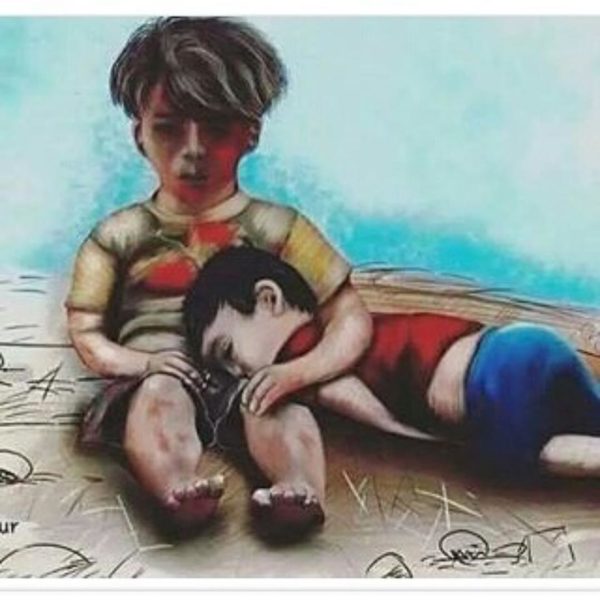
In the autumn of 2013, following the release of numerous photos and videos documenting the aftermath of chemical weapons attacks by Syrian president Bashar al-Assad, President Obama gave a televised address in which he directly referenced the images. He called on members of Congress and the viewing audience to watch the videos, and then consider the consequences of “choos[ing] to look the other way.”
Urging this spectatorship of videos that showed victims of all ages—some writhing, some crying out, some already dead—Obama evinced certainty that the images would prick the consciences of their viewers into action.
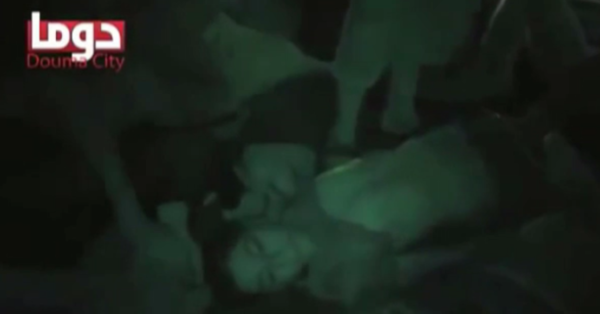
Still from a video shot in Duma, uploaded on August 21,2013, subsequently included in a collection of 13 videos compiled and re-posted by the U.S. Senate Select Committee on Intelligence.
In so doing, he captured key elements of this war’s visual culture: its tremendous productivity, coupled with widespread optimism that resultant images of the conflict and its humanitarian crises would provoke and sustain meaningful opposition to the war. So far, this optimism has been unfounded. And quite unintentionally, Obama’s remarks foreshadowed this outcome. After all, by the time he delivered this speech urging Americans to support military intervention in Syria, he had already decided not to pursue it.
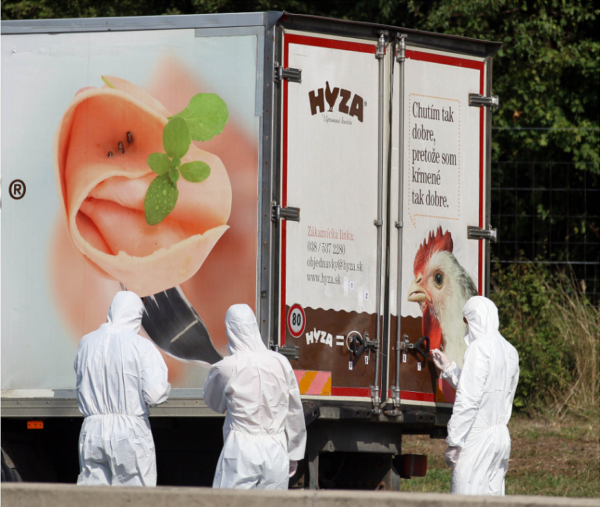
Officials inspect the truck abandoned on the side of an Austrian highway (Ronald Zak / AP)
A similar dynamic of investing an image with potential, and the image subsequently failing to realize it, has repeated itself many times in the intervening years. In the late summer of 2015, it happened with the photos of a truck found on the side of an Austrian highway containing the decomposing bodies of 71 migrants, Syrians among them.
None of those images showed the actual victims; spectators could only peer at the truck, plastered with advertisements for meat, and imagine its contents. Roughly a week later, it recurred with even more intensity around the photos of 3-year-old Alan Kurdi’s body prone on a Turkish beach.
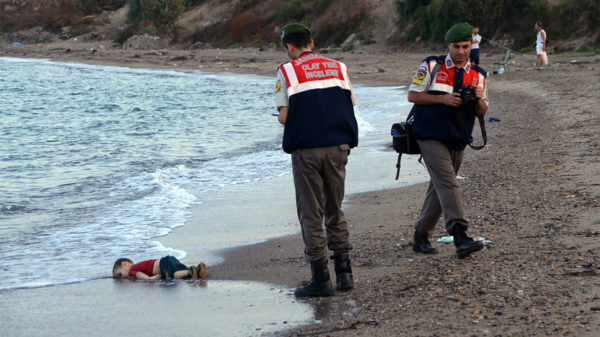
One of the shots of Alan Kurdi that went viral in the days after his death (AP)
These images, devoid of potentially off-putting graphic detail but flush with sentimental appeal, seemed to hold even more promise than those of the truck, which were both grisly and anonymous.
Most recently, this optimism catalyzed around the photo of Omran Daqneesh as he sat, bleeding and impassive, in the back of an ambulance in Aleppo last August. Following the release of the photo, the war in Syria continued apace, of course, while Daqneesh became an evolving meta-story. Countless recontextualizations and recirculations of the photo remade Daqneesh into a cipher for the virtues of many things: photojournalism, spectatorial empathy, and Western goodness.
In each afterlife, the photograph that began as a document of his suffering became the mechanism by which it was ultimately overshadowed.
Almost immediately, news organizations ascribed singular power to the photo. Some, like the Washington Post and NBC News, lauded its capacity to depict the ‘horror’ of the war. A reporter for NPR went further; she cited the preceding “flood of horrific photos” from Syria but argued that this image “resonated in a new way.” Such descriptions treated the photo’s power as self-evident, a contention apparently supported by quantitative information about how many times the photo had been shared on social media and assessments by journalists and critics. This consensus, in turn, generated analyses of why the photo had such an impact and editorial meditations on the photo’s transformative power. And so the photo itself, far more than the boy pictured within it, became the core of the story. Some news outlets raised questions; Al-Jazeera ran a decidedly skeptical segment about responses to the image, and the New York Times published a series of casualty photos featuring Syrian children who had been overlooked (three days after deeming Daqneesh’s image “extraordinary). But these interventions remained marginal.
For viewers that missed the photo rocketing around social media, CNN ran a story about it, reported by Kate Bolduan. The piece begins as a brief recap of the staggering casualty figures engendered by the conflict and a mention of the UN’s call for a ceasefire, as voiceover for the clip showing Daqneesh’s rescue from a bombed building, but ends as Bolduan’s lament over the image.
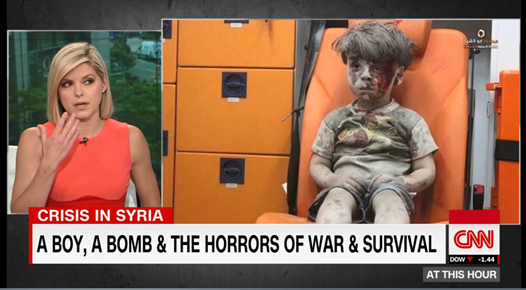
Still from the CNN report about Omran Daqneesh, which garnered worldwide attention for the anchor’s tearful reaction to his photo
In split-screen, with the photo enlarged, the anchor notes that “Omran” has become one of the millions of people displaced by the war. “What strikes me,” she says, after gesturing toward her own eyes as they fill, “is that we shed tears, but there are no tears here,” indicating the boy’s apparent emotionlessness.
Shortly thereafter, the photo fills the whole screen as Bolduan announces that Daqneesh was not among the three killed in the bombing: “This is Omran. He’s alive. We wanted you to know.” To date, however, the headline for the clip on the CNN website remains “Story of Little Syrian Boy Moves CNN Anchor to Tears.” In turn, those tears generated their own round of coverage.
Bolduan, in turn, was edged out of the limelight by a six-year-old boy from Scarsdale, New York, Alex Myteberi. Upon learning seeing the photos of Daqneesh, Myteberi was inspired to write a letter to President Obama with a request: “Can you please go get him?” In return, the young boy offered, “we will give him family.” Subsequently, Obama read aloud from Alex’s letter at the U.N.’s Leaders’ Summit on Refugees, and the White House wove a video of Alex reading his letter into a video of Obama addressing the group, exhorting them to follow Alex’s example. Posted on POTUS’ Facebook page, the video was viewed nearly 30,000,000 times. (Reflecting and reinforcing this viral popularity, my Google searches for “Omran Daqneesh” in the following weeks instead led me to stories about Alex and his letter.) The video of Alex shows him in a pale blue Oxford shirt, adorably dwarfed by a large dining room table, where he sits and reads his letter.
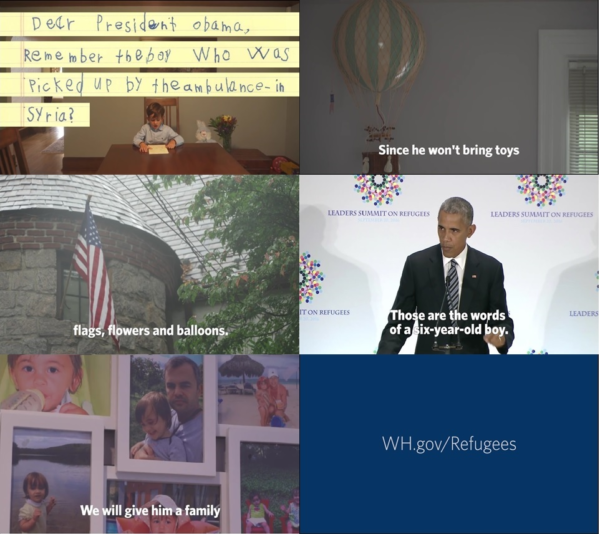
Stills from the White House video of 6-year-old Alex Mkyteberi reading his letter to President Obama.
The picture cuts between Alex himself, and shots of the comfortably-appointed house, with American flag blowing gently in the breeze out front. Periodically, the camera lingers on happy photos of the Myteberi family, as if to highlight the contrast between these images and those of Omran, pictured alone and unsmiling. Obama ventriloquized Alex’s sentiment to a smattering of applause, exhorting other world leaders to follow the young boy’s example. In the process, Alex’s words, as expressions of goodness, compassion, and innocence become a way of reconciling the U.S.’s ambiguous place in the conflict and its relatively minimal commitment to aiding refugees displaced by it.
A final, and photogenic, chapter was added to Alex’s story in November, when Obama invited him to the White House for a visit, in which the President personally praised Alex for being “so nice and kind.”
My goal here is not to question anyone’s sincerity or to hint that any of these public displays of sentiment were staged or embellished. In many ways, it is immaterial whether these reactions were ‘real’ or ‘genuine.’ Rather, my interest lies in the paradox animating these afterlives of Daqneesh’s photo. The image was initially hailed as a lucid document of his suffering, and it was this eloquence that propelled it onto innumerable viral circuits. But Daqneesh’s suffering essentially disappeared at the very moment it became visible.
We cannot know what it was about Daqneesh’s photo that made it so compelling, why this image, out of the torrent of visualized misery from Syria, proved so catalytic to so many. Many commentaries on the image emphasize Daqneesh’s impassivity, and identify his emotionlessness as a key source of the photo’s power; as Bolduan observes, “he doesn’t cry once.” Perhaps this is part of what facilitated the displacements I’ve analyzed here, as observers read Daqneesh’s blank face as an invitation to laminate their own feelings onto, and over, the photo. Ultimately, this global outpouring found a distorted echo in other quarters. For example, China’s state-run CCTV alleged that the photo was staged as Western propaganda against the Syrian government. Assad similarly denied the authenticity of the photo; likewise the Russian military. All of these doubts are easily dismissed, but nonetheless represent a final mediated displacement of Daqneesh and his suffering.
More recently, Syrian children like Kurdi and Daqneesh have reemerged as touchstones in the debate over Trump’s ban on refugees, as in this newspaper cartoon posted on Instagram.
And on January 30, Pete Souza, the White House photographer for Obama, Instagrammed a photo of Alex and his family in the Oval Office, ostensibly as a rejoinder to the policy announced three days earlier.
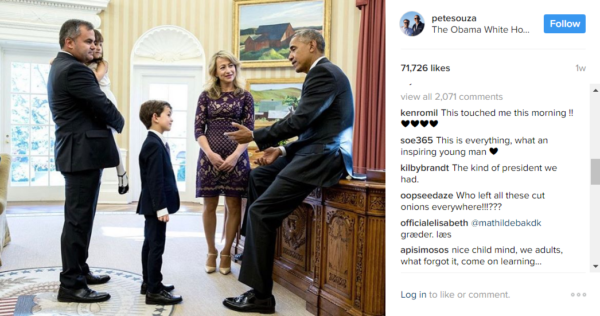
Alex at the White House in November, reposted by Pete Souza on January 30, 2017
But here again, Daqneesh appears only by proxy, represented by his would-be brother. The photo garnered over 71,000 “likes” and 2000 comments. Admittedly, I only scrolled through a few hundred, but the patterns are clearly discernible. Most of them are praise for Alex, or the familiar Instagram responses of emoji faces and hearts to encapsulate a reaction. There are plenty of expressions of nostalgia for Obama. A few people ask “What happened to the little Syrian boy?” (Here is one answer.) But no one identifies Omran Daqneesh by name.
— Rebecca Adelman
(The drawing leading the post has been widely published on social media. The artist is unknown.)
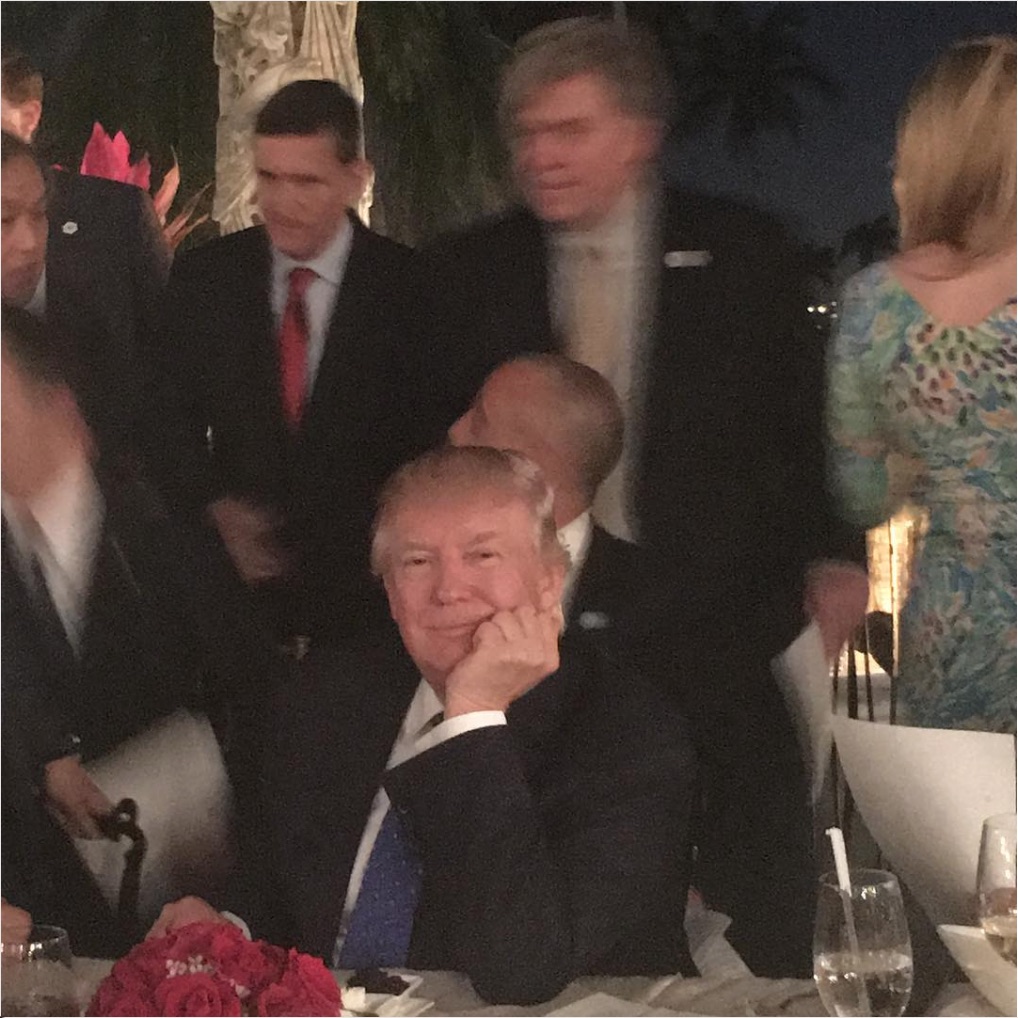
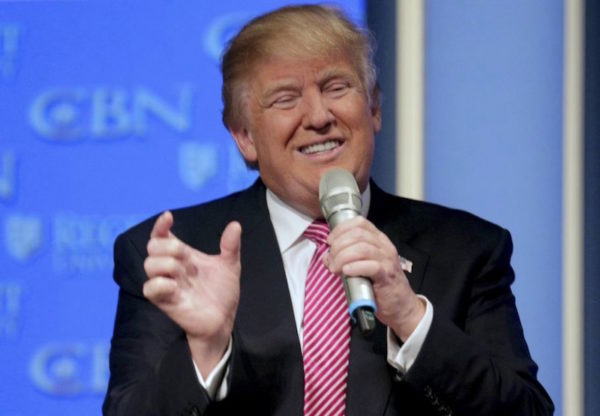
Reactions
Comments Powered by Disqus